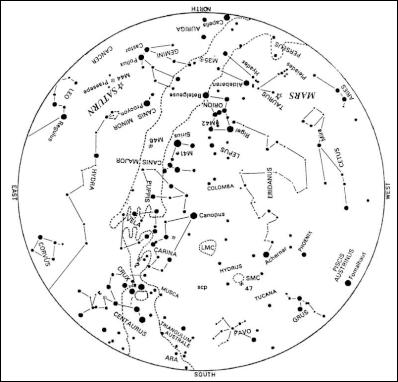Brian Carter's February Night Sky
The Night Sky
Carter Observatory
The National Observatory Of New Zealand
THE FEBRUARY NIGHT SKY
The nights are noticeable getting longer for looking at the planets and stars.
Planets
February is a good month for viewing the planets. Venus, Mars, Jupiter and Saturn will be visible for the whole of the month. Only Mercury will not be seen in February.
Mars will be visible for the first third of the night. At the start of the month it sets at 00:43 and at 23:37 by month’s end. Mars starts the month in the constellation of Aries, moving into Taurus on February 7. Its magnitude fades from 0.2 to 0.7 during the month.
Saturn will be visible for the first three quarters of the night. At the start of February it sets at 06:11 and at 04:15 by month’s end. Saturn is in the constellation of Cancer, in which it remains until September 2006. Its magnitude slightly fades from –0.2 to –0.1.
Jupiter will be visible for the last two thirds of the night. At the start of the month it rises at 00:38 and by month’s end at 22:53. Jupiter is in the constellation of Libra, in which it remains until December 2006. Its magnitude slightly increases from –2.0 to –2.2 during the month.
Venus can be seen in the morning sky. At the start of the month it rises at 04:46 and at 03:36 by month’s end. Venus is in the constellation of Sagittarius. Its magnitude starts the month at –4.5, rising to its brightest for the year at –4.6.
Mercury, although in the evening sky, is visually too close to the Sun to be seen. It will reappear in the morning sky half way through March. Mercury starts the month in the constellation of Capricornus, moving into Aquarius on February 8 and finally into Pisces on February 22.
All times are for Wellington unless otherwise stated. Other centres may vary by a few minutes.
Phases of the Moon
First Quarter – February 5 at 19:29.
Full Moon – February 13 at 17:44.
Last Quarter – February 21 at 20:17.
New Moon – February 28 at 13:31.
Diary of Astronomical Phenomena
Feb 3 Venus stationary
against the background stars at 20:00, as its motion changes
from a Westerly to an Easterly direction.
12 Saturn 4ºS
of Moon at 04:00
13 Full Moon at 17:44.
14 Moon at
apogee (furthest from the Earth) at 14:00 (Distance =
0.0027163 AU = 406,350 km).
18 Venus greatest illuminated
extent at 09:00.
24 Mercury at greatest Easterly
elongation from the Sun (18) at 18:00.
28 Moon at
perigee (closest to the Earth) at 09:00. (Distance =
0.0023856 AU = 356,880 km).
28 New Moon at
13:31.
This chart shows the sky as it appears at about 22:00 for February.
How To Use the Sky Charts
To use the sky chart hold it up to the sky so that the direction in which you are looking is at the lower edge of the map. For example, if you are looking at the western horizon then the map should be held so that the “WEST” label is at the lower edge. The altitude and direction of the stars and planets will then be correctly shown. The centre of the chart will be directly overhead.
* Brian Carter is the Senior Astronomer at Carter Observatory (The National Observatory of New Zealand), PO Box 2909, Wellington. (Observatory Web Site: www.CarterObservatory.org)



 DC Harding: In The Spirit Of Natural Justice
DC Harding: In The Spirit Of Natural Justice Martin LeFevre - Meditations: Animal Encounters During Meditative States
Martin LeFevre - Meditations: Animal Encounters During Meditative States Ian Powell: Gisborne Hospital Senior Doctors Strike Highlights Important Health System Issues
Ian Powell: Gisborne Hospital Senior Doctors Strike Highlights Important Health System Issues Keith Rankin: Who, Neither Politician Nor Monarch, Executed 100,000 Civilians In A Single Night?
Keith Rankin: Who, Neither Politician Nor Monarch, Executed 100,000 Civilians In A Single Night? Eugene Doyle: Writing In The Time Of Genocide
Eugene Doyle: Writing In The Time Of Genocide Gordon Campbell: On Wealth Taxes And Capital Flight
Gordon Campbell: On Wealth Taxes And Capital Flight